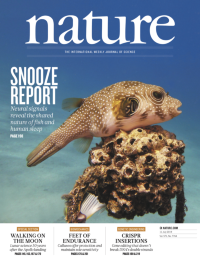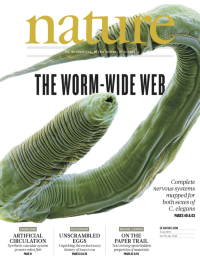Volume 571
-
No. 7766 25 July 2019
Cell dynamicsThe proteins known as ABC exporters are highly dynamic molecular machines found in the cell membrane. They extrude a variety of substances from within the cell and as a result are involved in several key processes, including adaptive immunity and multidrug resistance. In this week’s issue, Robert Tampé, Arne Moeller and their colleagues report eight structural snapshots of an ABC reporter called TmrAB in action, presenting a picture of the various conformations adopted by the protein during substrate transport. The cover shows multiple protein complexes of TmrAB (blue and yellow) embedded in a cell membrane. The researchers used cryo-electron microscopy to capture the states in an imaging process that should be applicable to other transporters, many of which are intimately linked to human physiology and diseases.
Career Guide
-
No. 7765 18 July 2019
Quantum logicQubits based on the electron spin of phosphorus atoms show huge promise as a platform for quantum computing. To create logic gates — the building blocks of a processor — the electron spins are placed extremely close together enabling strong interactions and fast gate operation times. Although entanglement has been achieved in silicon quantum dots, it has proved elusive for interactions between two electrons bound to atom qubits. In this issue, Michelle Simmons and her collaborators report a nanosecond two-qubit exchange gate in silicon between electrons on phosphorus donor atoms. The researchers achieved this by engineering qubit placement and its associated control circuitry at the atomic scale to attain high-fidelity readout of the spin states. The creation of this fast exchange gate moves a large-scale quantum circuit using electron-spin qubits in silicon a step closer to reality.
-
No. 7764 11 July 2019
Snooze reportWhat is sleep like for fish? That is the question addressed in this week’s issue by Philippe Mourrain, Louis Leung and their colleagues. Although various stages of sleep have been identified and defined in mammals, birds and reptiles, it was not clear if the same held true for other vertebrates such as fish. Using non-invasive molecular, imaging and physiological tools, the Stanford researchers observed neural signatures in zebrafish that can be identified as at least two different sleep states. These states bear similarities to the slow-wave sleep and rapid eye movement sleep states seen in other organisms. The identification of such signatures in fish suggests that these sleep states may have emerged in the vertebrate brain more than 450 million years ago.
-
No. 7763 4 July 2019
The worm-wide webKnowing how the components of a nervous system are connected together is crucial for understanding how that system works. In this week’s issue, Scott Emmons and his colleagues present complete wiring diagrams for both sexes of the model organism Caenorhabditis elegans. These neural maps, or connectomes, which update an influential 1986 publication, were built up from both new and previously published electron micrographs and encompass all connections in the nematode from sensory input to end-organ output. The maps have allowed the researchers to determine the location of each synapse and to assign an indirect measure of the strength of each connection based on the physical size of its constituent synapses. The team was also able to make direct comparisons between the two sexes, and estimate that some 30% of the connections may be substantially different in strength between the male and the hermaphrodite. The two connectomes should help to identify the neural circuits responsible for the nematode worm’s behaviour.




